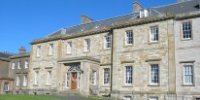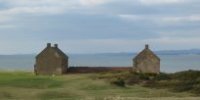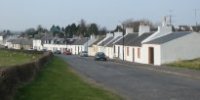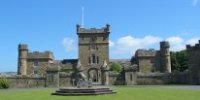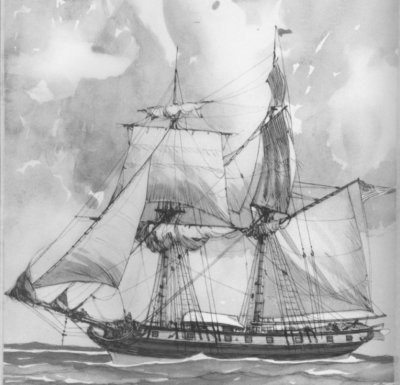a late-18th Century brig |
Captain
John Smith was a merchant seaman who lived in Newton upon Ayr in
the late eighteenth and early nineteenth centuries. He was a comparatively
wealthy man when he died (on 19th November 1817), leaving a personal
estate of £2764. (note 1) According to the conventional adjustment
for inflation, this is equivalent to £87,094 today, but this
calculation considerably misrepresents his wealth. (note 2) Most
of his money was on deposit, with the balance consisting of rents
due to him. At 5 per cent, which was the yield on his promissary
notes, the annual income was about £138, much above that enjoyed
by the majority of tradesmen and professional men at the time. Whereas
the sum of £87,094 today would yield only £4355 at 5
per cent before tax (if that rate could be found), not much more
than half the national minimum wage which from 1st October will
be £4.50 an hour, amounting £8190 a year based on a
35 hour week. This is an illustration of how incomplete and distorted
a picture can be given by inflation adjustments over extended periods.
Smith was skipper of, and had shares in, a number of brigs built
by the partnership of Robert Ralston and Robert Smith, which possessed
a timber and ship-building yard on the Newton shore of the river
Ayr. (note 3) He was probably the John Smith who, with Dr Robert
Smith, was a trustee of Robert Smith the partner. Both partners
died in 1806 and their business was wound up. Captain John Smith
had shares in Ocean and Favorite [sometimes spelt Favourite]. There
were also shares held by John Smith, probably the captain, in Juno,
Hercules, and Britannia. The inventory of his personal estate shows
that he had a one-sixteenth share in Favorite at his death, then
valued at £40.
These boats were generally described as 'brigs' (see illustration),
although the term 'brigantine' sometimes appears. (note 4) Their
principal business was the carriage of coal from Ayr to various
Irish ports - most frequently Dublin; Portaferry, Drogheda, Waterford,
and Cork also occur. There were voyages further afield: to Pictou,
Montreal, Quebec, Riga, Stockholm, and Memel. From Ireland they
often returned with limestone to Ayr, or carried this to Barnstaple,
Portsmouth, or Southampton, returning to Ayr with cargoes of timber
or bark.
Apart from his earnings as skipper, which are not known, he enjoyed
a substantial return on his shares in the boats. Hercules repaid
its shareholders in full in four years, and in eight years dividends
amounted to 230 per cent of the cost of the boat. Whether in addition
he enjoyed any inheritance from Robert Smith is not known.
Captain Smith was married to Jean Chalmers. When his will was drawn
up in May 1817, they had no living children. He left the whole of
his personal estate to his wife 'in liferent', to be put on deposit
or invested in property to provide an income, which, as remarked
above, would have been substantial. After her death there were some
family and other bequests to be made, amounting to £440, and
the residue, possibly as much as £2324 and much later described
as 'fully £2000', was left to provide for the education of
the children of the poor.
His will stipulated that:
The yearly rents arising from the said purchased lands or interest
of the said Jean Chalmers my spouse shall be applied by ... the
Provost two Baillies & ministers of the Established Church of
the Burgh of Ayr for the time being and their successors in place
and office ... for the purpose of educating or assisting in the
education of certain poor children in the Burgh & parish of
Ayr whose parents live therein and are unable to educate them to
be nominated by the said Magistrates & Ministers from time to
time and these children thus to be presented shall only be taught
to read English, Writing, and what is called the five common rules
of Arithmetic so that they may be fitted for the common occupations
of life. But if the managers of this fund shall at any time find
a Young person whose parents live within the said Burgh & parish
of Ayr whom they may think possessed of uncommon abilities and who
shall discover a strong inclination for learning are hereby allowed
to apply what proportion they may think proper of the said rents
or interest for the instructing of such Young person in what other
branches of education they may think proper.
So generous was this bequest that 27 years later it was still the
greatest of the many 'posthumous benefactions to the poor' with
which Ayr 'abound[ed]', exceeding in value those of many with higher
positions in society, including Sir Robert Blackwood, Lady John
Campbell, and Mrs Crawford of Ardmillan. (note 5) According to the
account in the NSA, the bequest was applied to the funding of an
existing school for poor children, in place of the subscriptions
which had provided for it hitherto, and which was taught in a vacant
room in the poorhouse of Ayr. Elsewhere it is stated that 'Smith's
Institution' was established in 1825, again in the poorhouse, where
in 1838 'William McDerment single-handed taught 245 pupils'. (note
6) A new building was erected nearby for the school in 1842, '"one
of the largest and most commodious schoolrooms in the County"
measuring 54 x 26 x 17 feet, to which a second storey was added
in 1867; by which time 300 scholars paying a penny a week and 70
poor children enrolled free were taught by a staff of three teachers
and two pupil teachers.' (note 7)
Smith's Institution was named on the first Ordnance Survey map of
1857 (see illustration showing the Townhead of Ayr - Kyle Street
is on the left, Mill Street top right, and Smith's Road, later Smith
Street, runs between at an angle to the railway line). The group
of buildings immediately above it and to the left of the quarry
are the premises of J & A Taylor, Engineers, while the 'Poor's
House' can be seen on the extreme right.
Following the Education (Scotland) Act of 1872, Smith's Institution
became the responsibility of the Ayr Burgh School Board, and in
1884 it moved into new premises in Holmston Road; in 1930 its name
was changed to Holmston School. Holmston Primary School is in the
same building today. (note 8)
According to Rob Close, Smith Street, formerly Smith's Road, owes
its name to the institution endowed by and named after Captain John
Smith. (note 9) Although otherwise long forgotten, he was a significant
benefactor to the poor of Ayr, to whom thousands of children owed
their basic education between 1825 and 1872.
Notes
1. National Archives of Scotland, SC36/48/13, inventory and settlement
of John Smith, 6th July 1818.
2. Bank of England, 'Equivalent contemporary values of the pound:
a historical series 1270 t0 1999', adjusted by David McClure for
inflation from 1999 to 2002.
3. Various journals and ship's books are to be found in the National
Archives of Scotland: CS96/654 to CS96/668.
4. 'Brig' was initially an abbreviation of 'brigantine'. By the
end of the eighteenth century they referred to two different types
of two-masted rigging. Lloyd's Register of 1790 includes 'brig'
but not 'brigantine', which appeared as a distinct rig in the Register
of 1834. This information was taken from David R. MacGregor, Merchant
Sailing Ships: Sovereignty of Sail 1775-1815, London 1985.
5. New Statistical Account of Scotland, Vol. V, 81. The Ayr parish
account was written by Rev. Robert Auld and Rev. Alexander Cuthill.
6. John Strawhorn, The History of Ayr: Royal Burgh and County Town,
Edinburgh 1989, 196.
7. History of Ayr, 196.
8. History of Ayr, 197-200, and 221.
9. Rob Close, The Street Names of Ayr, AANHS, Ayr 2001.
© David McClure 2003
|

